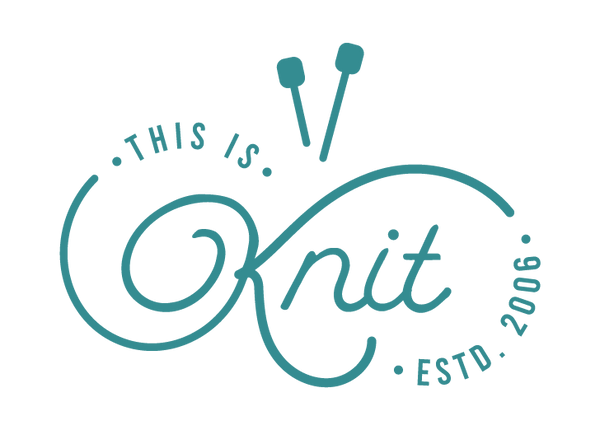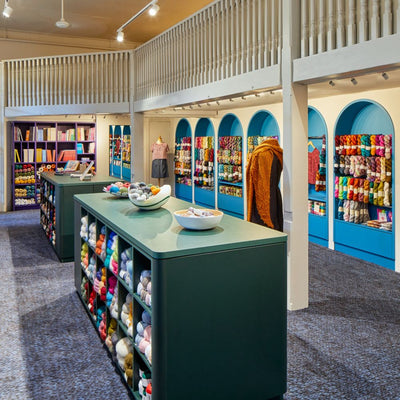In pattern
June 11 2013 – thisisknit
 "Cast off in pattern." It's a fairly common instruction, but one that often causes confusion, so we thought a tutorial would be useful.
First of all, the reason why. Different stitch patterns have different properties - stocking stitch is flat, moss stitch ripples gently from one stitch to another, rib pulls in. If your cast off mimics the stitch pattern that's gone before, you end up with a cast-off edge with matching properties. If you don't, then it won't, and you may end up with a cast-off edge that pulls in more than the rest of the fabric, or splays out more.
In what follows, we're using the example of 2x2 rib. In our wee swatch, there's 20 stitches, which is a multiple of 4 (two knits and two purls), so it's easy to know what we're up to: every row begins with two knits.
"Cast off in pattern." It's a fairly common instruction, but one that often causes confusion, so we thought a tutorial would be useful.
First of all, the reason why. Different stitch patterns have different properties - stocking stitch is flat, moss stitch ripples gently from one stitch to another, rib pulls in. If your cast off mimics the stitch pattern that's gone before, you end up with a cast-off edge with matching properties. If you don't, then it won't, and you may end up with a cast-off edge that pulls in more than the rest of the fabric, or splays out more.
In what follows, we're using the example of 2x2 rib. In our wee swatch, there's 20 stitches, which is a multiple of 4 (two knits and two purls), so it's easy to know what we're up to: every row begins with two knits.
 In order to stay in pattern, the first two stitches need to be worked knitwise, so here we are knitting the first of them. And the second one gets worked knitwise too:
In order to stay in pattern, the first two stitches need to be worked knitwise, so here we are knitting the first of them. And the second one gets worked knitwise too:
 And then the first gets hopped over the second as usual to cast it off:
And then the first gets hopped over the second as usual to cast it off:
 To stay in pattern, the next two stitches need to be worked purlwise - you can see the bump on the front of the first stitch on the left hand needle here:
To stay in pattern, the next two stitches need to be worked purlwise - you can see the bump on the front of the first stitch on the left hand needle here:
 So the yarn needs to come to the front of the work, and that stitch is purled. When it comes time to hop the previous stitch over this purled one, the yarn's at the front.
So the yarn needs to come to the front of the work, and that stitch is purled. When it comes time to hop the previous stitch over this purled one, the yarn's at the front.
 You may find it quite comfortable to do the hop-over with the yarn at the front (it'll need to be there for the next stitch, because that's going to be purled too). On the other hand, a lot of people find it less cumbersome to bring the yarn to the back out of the way before the hop-over. Try them both out, and see which you prefer.
You may find it quite comfortable to do the hop-over with the yarn at the front (it'll need to be there for the next stitch, because that's going to be purled too). On the other hand, a lot of people find it less cumbersome to bring the yarn to the back out of the way before the hop-over. Try them both out, and see which you prefer.
 If you do choose to slip the yarn backwards, just remember to bring it back to the front for the next purled stitch:
If you do choose to slip the yarn backwards, just remember to bring it back to the front for the next purled stitch:
 That's the procedure for this whole cast off - each time, check how the pattern would want the stitch to be worked if you weren't casting off but working a normal row in pattern, and then do it that way.
For our wee rib sample the result is a cast off edge which pulls in the same amount as the fabric below it - you can see it in the picture at the top of the post. When you look at the top edge, you can see the stitches waving happily from side to side, following the rib and giving you snug elasticity.
That's the procedure for this whole cast off - each time, check how the pattern would want the stitch to be worked if you weren't casting off but working a normal row in pattern, and then do it that way.
For our wee rib sample the result is a cast off edge which pulls in the same amount as the fabric below it - you can see it in the picture at the top of the post. When you look at the top edge, you can see the stitches waving happily from side to side, following the rib and giving you snug elasticity.
 On a different note, our Color Affection Knit-Along is coming to a triumphant end, and there's a gorgeous Coolree Yarns prize up for grabs. So if you knitted one (or two, or many!), make sure you post a Finished Object picture in the Ravelry thread! And the best of luck!
On a different note, our Color Affection Knit-Along is coming to a triumphant end, and there's a gorgeous Coolree Yarns prize up for grabs. So if you knitted one (or two, or many!), make sure you post a Finished Object picture in the Ravelry thread! And the best of luck!


0 comments